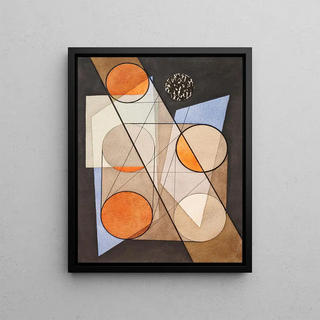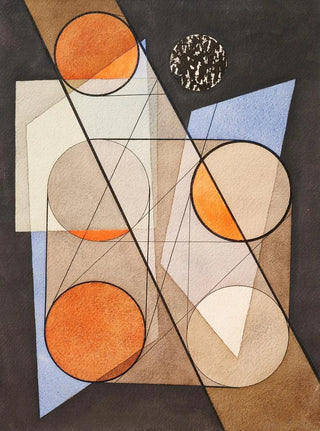Art print | Composition with Symmetrical Circles - László Moholy-Nagy


View from behind

Frame (optional)
In the fascinating world of modern art, "Art print with symmetrical circles" by László Moholy-Nagy stands out for its boldness and innovation. This iconic piece, embodying the principles of constructivism and the Bauhaus, invites viewers to explore a universe where form and color meet in captivating harmony. Through a meticulous arrangement of colored circles, Moholy-Nagy manages to create a visual dynamic that transcends traditional painting boundaries. Each circle, with its vibrant hue, appears to float in an infinite space, prompting reflection on perception and the interaction between art and environment.
Style and uniqueness of the work
Moholy-Nagy's style is characterized by an avant-garde approach that challenges the artistic conventions of his time. "Art print with symmetrical circles" features a perfect balance between abstraction and geometry. The circles, arranged symmetrically, generate a sense of movement, as if the piece is constantly evolving. The color palette, ranging from primary hues to more subtle shades, enriches this composition with unprecedented visual depth. The artist skillfully plays with light and shadow, creating depth effects that invite the viewer to explore every detail. This work is not only an aesthetic representation but also a reflection on the impact of technology and industrialization on art, a theme dear to Moholy-Nagy.
The artist and his influence
László Moholy-Nagy, a key figure of the 20th century, left a mark on art history through his innovative approach and avant-garde vision. Born in Hungary, he quickly joined the Bauhaus movement, where he developed an artistic philosophy advocating the union of art and industry. His influence extends beyond painting, touching fields such as photography, graphic design, and even architecture. Moholy-Nagy always sought to democratize art, making it accessible to all, and to use new media to express his ideas. His ability to merge theory and practice has inspired many contemporary artists.

Matte finish

View from behind

Frame (optional)
In the fascinating world of modern art, "Art print with symmetrical circles" by László Moholy-Nagy stands out for its boldness and innovation. This iconic piece, embodying the principles of constructivism and the Bauhaus, invites viewers to explore a universe where form and color meet in captivating harmony. Through a meticulous arrangement of colored circles, Moholy-Nagy manages to create a visual dynamic that transcends traditional painting boundaries. Each circle, with its vibrant hue, appears to float in an infinite space, prompting reflection on perception and the interaction between art and environment.
Style and uniqueness of the work
Moholy-Nagy's style is characterized by an avant-garde approach that challenges the artistic conventions of his time. "Art print with symmetrical circles" features a perfect balance between abstraction and geometry. The circles, arranged symmetrically, generate a sense of movement, as if the piece is constantly evolving. The color palette, ranging from primary hues to more subtle shades, enriches this composition with unprecedented visual depth. The artist skillfully plays with light and shadow, creating depth effects that invite the viewer to explore every detail. This work is not only an aesthetic representation but also a reflection on the impact of technology and industrialization on art, a theme dear to Moholy-Nagy.
The artist and his influence
László Moholy-Nagy, a key figure of the 20th century, left a mark on art history through his innovative approach and avant-garde vision. Born in Hungary, he quickly joined the Bauhaus movement, where he developed an artistic philosophy advocating the union of art and industry. His influence extends beyond painting, touching fields such as photography, graphic design, and even architecture. Moholy-Nagy always sought to democratize art, making it accessible to all, and to use new media to express his ideas. His ability to merge theory and practice has inspired many contemporary artists.






